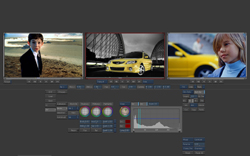
PRODUCT: Discreet Smoke 6 on Tezro and Linux
WEB SITE: www.discreet.com
PRICE: Starts turnkey at $68K US. Pricing varies by configuration. Contact Discreet for details.
- Multi-resolution freedom
- The new Master Keyer
- The new Color Warper
The latest release of Discreet's high-end editing software, Smoke, is set to hit workstations this month. The new version will bring a bevy of features to editing desktops that were previously only available to Flame and Inferno users. Add the new SGI Tezro and you have a potent editing package with serious horsepower. The other big hardware news is the release of the package on Red Hat Linux 8. Although this system runs on a standard IBM IntelliStation Z Pro 6221 with an Nvidia graphics card, it will only be available in a turnkey package. During our tests, the only difference on the Linux platform was less speed and fewer resolutions. The Linux platform will be a very solid alternative to the higher cost SGI systems for facilities where standard definition is the normal finish of choice. The Linux package should be available in March of 2004.
THE POWER
I tested Smoke running on the new SGI Tezro, which is available with up to four processors, with speeds approaching that of the Onyx supercomputers that drive Smoke's big brother, Fire. With four processors and four PCI-X busses, the Tezro can chew through multi-resolution timelines with ease. The power of this new computer became immediately apparent during testing when renders for complex high definition work took about half the time that they do on the previous Octane 2 system. Playing back 2K frames in 12-bit mode will make this new release particularly attractive to high-end post houses that need to maintain image quality throughout the editorial and effects pipeline. The speed of the software on the Tezro will make it an ideal choice for longform, multi-resolution work where there's the need to provide instant feedback to session clients.
Smoke 6 offers a range of new creative features that are sure to please both new converts and existing editors using Version 5 of the software. The list of new features reads more like a Flame brochure than that of an editing package, and will certainly blur the line between what we think of as editing and compositing. During my review it performed flawlessly, with toolsets for almost every imaginable problem and effects scenario, along with a very solid set of editing tools. By the end of the session, it became apparent that this release is aimed at an increasingly demanding marketplace that needs to have more speed, greater control and better value. At an opening price of about $68K for the Linux version, Smoke 6 is not a tool for casual users. The learning curve can be steep, including learning a new OS if you're not familiar with Irix or Linux.
NEW FEATURES
The most notable new feature is the multi-resolution timeline and media support. With a new soft resize tool, incorporating different sized media into any size timeline is effortless. The resize window marquee is easy to use and gives instant feedback on pans and scans without having to visit the coffee station during renders. This feature opens the door to true multi-mastering capabilities, allowing you to work at virtually any resolution or frame rate and aspect ratio. Panning or zooming large resolution stills or clips is as easy as dragging the tool around the image and planting keyframes. The new Master Keyer is sure to save hours for anyone that has challenging keys to pull on a regular basis. With guru-like intuitiveness, this latest keyer is able to pull mattes from the most difficult situations. It excels at fixing problems, like badly lit blue- or greenscreens, compression associated with HDCAM and film grain. As you work on your key, selecting a region of interest produces relevant tools that "pop-up" to help you make changes to settings that will produce a better key.
When it comes time to take out the garbage, the new Gmask (garbage mask) advanced gradient feature gives you more control over variable edge softness. The tool is particularly handy when dealing with motion elements, allowing control over the edge blur at every point on the spline. As with many of the tools in this software, Discreet also allows you to incorporate trackers at any stage of your workflow. This can be a huge time saver when dealing with masks that need to follow a moving object or edge. The tracking system within Smoke is perhaps one of its most valuable resources. It's lightning fast and easy to use, even for a newcomer to the software. Another feature that has trickled down from the Flame is the new extended bicubic setting for surfaces. This new feature gives you greater control over the surface, allowing you to warp image layers in 3D space. While this might at first be thought of as a "gee-whiz" feature, the extra control made matching up two slightly different shots a breeze. With multiple points on the image surface, it was easy to slightly change the shape of a foreground image during a transition, keeping the two shots matched despite a camera angle change.
Color correction has not been forgotten either. The addition of the color warper is a welcome solution for tough color situations that require manipulation of specific colors in an image. Primary and secondary correction was a breeze with multiple target color selections and easily-used masks.
CONCLUSION
Smoke 6 is a solid editing system with a tool set that, although a little overwhelming at first, gives the editor almost god-like control over every element of a project. For smaller facilities, the new Linux release should provide a cost-effective alternative to SGI hardware, and the number of tools that have trickled down from the much more expensive Flame/Inferno boxes will keep any technophobe happy at the effects level. I can't wait to get my release!